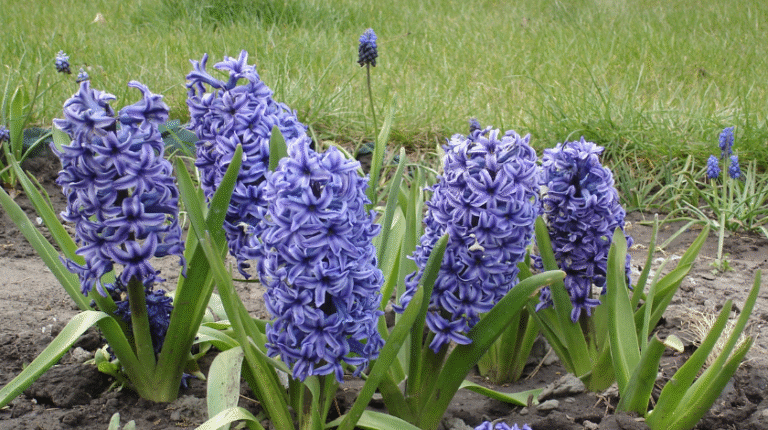Jacinthe (Hyacinthus orientalis), also known as common hyacinth, is a beloved spring-flowering bulb recognized for its intensely fragrant blossoms and vibrant flower spikes. Native to the Eastern Mediterranean, particularly Turkey, Syria, and Lebanon, this perennial bulb has enchanted gardeners across Europe and beyond for centuries.
As we explore the rich history, botanical features, cultivation techniques, care instructions, and symbolic meanings of Hyacinthus orientalis, we aim to provide a thorough guide for both beginners and seasoned horticulturists.
Botanical Profile of Hyacinthus Orientalis
-
Botanical Name: Hyacinthus orientalis
-
Common Names: Jacinthe, Common Hyacinth, Garden Hyacinth
-
Family: Asparagaceae
-
Genus: Hyacinthus
-
Hardiness Zones: USDA 4–8
-
Bloom Time: Early to mid-spring
-
Plant Type: Bulbous perennial
-
Height: 8–12 inches (20–30 cm)
The hyacinth’s dense, cylindrical racemes contain dozens of waxy, bell-shaped florets that emit a powerful, sweet fragrance. Flower colors range from deep purple, rose, and pink to white, yellow, and blue, offering a spectacular burst of color after winter’s dormancy.
History and Etymology of the Jacinthe Flower
The name “Hyacinthus” finds its roots in Greek mythology, where Hyacinthus was a beautiful youth loved by Apollo. After a tragic accident, a flower sprung from his spilled blood, giving rise to the poetic and tragic symbolism of the flower. The term “Jacinthe” is derived from the French translation of the Latin “hyacinthus,” emphasizing its romantic and noble connotation across cultures.
Ideal Growing Conditions for Hyacinthus Orientalis
1. Soil Requirements
Jacinthe thrives in well-drained, moderately fertile soil. Avoid waterlogged areas, as bulbs are prone to rot. The ideal soil pH ranges from 6.0 to 7.0, slightly acidic to neutral.
2. Light Conditions
For optimal blooming, plant in full sun to partial shade. A minimum of 6 hours of direct sunlight is ideal, especially in colder climates.
3. Climate and Temperature
Hyacinthus orientalis requires a cold dormant period to bloom effectively. In warmer regions, pre-chilled bulbs (chilled at 40–45°F/4–7°C for 10–12 weeks) are necessary to simulate winter dormancy.
How to Plant Hyacinthus Bulbs Successfully
When to Plant
Plant hyacinth bulbs in autumn, approximately 6–8 weeks before the first frost, typically from late September to early November, depending on your region.
Planting Depth and Spacing
-
Depth: 6–8 inches (15–20 cm)
-
Spacing: 4–6 inches (10–15 cm) apart
Plant bulbs with the pointed end facing upwards. Water thoroughly after planting to settle the soil.
Container Planting
Hyacinths grow well in containers, especially in regions with unpredictable winters. Use well-draining potting soil, and ensure adequate chilling if grown indoors.
Care and Maintenance of Jacinthe Flowers
Watering
Water moderately during active growth. Overwatering can cause bulb rot. Once foliage dies back in late spring, reduce watering.
Fertilizing
Apply a balanced bulb fertilizer (10-10-10) at the time of planting and again in early spring when shoots emerge.
Post-Bloom Care
After blooming, remove faded flowers but allow the foliage to die back naturally, as it feeds the bulb for the next season. In mild climates, bulbs can be left in the ground; in colder regions, consider lifting and storing bulbs.
Pest and Disease Management
-
Pests: Aphids, bulb mites
-
Diseases: Grey mold (Botrytis), bulb rot
Maintain proper air circulation and avoid overhead watering to minimize disease risks.
Propagation of Hyacinthus Orientalis
Jacinthe can be propagated through:
1. Offsets (Bulblets)
Small bulblets form around the mother bulb. Lift the bulb after foliage dies back, separate bulblets, and replant in autumn. These may take 2–3 years to flower.
2. Seed (Less Common)
Seed propagation is rarely used, as it takes 5–6 years to bloom. Typically reserved for breeding purposes.
Indoor Forcing of Hyacinths
Hyacinths are ideal for indoor forcing, allowing blooms during winter months. Follow these steps:
-
Choose healthy, pre-chilled bulbs or chill them in the fridge for 10–12 weeks.
-
Plant in pots with a portion of the bulb above soil level.
-
Place in a dark, cool location (35–48°F or 2–9°C) for root development.
-
After 8–12 weeks, move to bright indoor light and enjoy the blooms.
Popular Varieties of Hyacinthus Orientalis
-
‘Blue Jacket’ – Deep blue with silver highlights; award-winning fragrance.
-
‘Pink Pearl’ – Soft pink with a sweet aroma.
-
‘Carnegie’ – Pure white, excellent for indoor forcing.
-
‘City of Haarlem’ – Pale yellow, a rare color in hyacinths.
-
‘Woodstock’ – Rich burgundy-purple, striking in mixed beds.
Companion Planting with Jacinthe
Hyacinths pair well with other spring bloomers like:
-
Tulips
-
Daffodils
-
Crocuses
-
Muscari (Grape Hyacinths)
-
Pansies and Violas
Use in borders, rock gardens, and container displays for layered color and fragrance.
Symbolism and Cultural Significance
In Victorian flower language, hyacinths symbolize playfulness, sincerity, and constancy. Each color has unique meanings:
-
Blue: Constancy and sincerity
-
Purple: Sorrow or forgiveness
-
White: Purity and loveliness
-
Pink/Red: Playfulness and passion
Jacinthe is widely used in spring festivals, Easter arrangements, and wedding bouquets, especially in Europe.
Toxicity Warning
All parts of Hyacinthus orientalis are toxic to humans and pets, particularly the bulbs, which contain oxalic acid. Always wear gloves when handling and keep out of reach of children and animals.
Conclusion
Hyacinthus orientalis, or Jacinthe, remains a timeless springtime classic. With its intoxicating fragrance, bold color palette, and historical depth, it offers both aesthetic and emotional value to gardens worldwide. Whether grown in borders, containers, or forced indoors, hyacinths bring elegance and joy with minimal effort when properly cared for.

